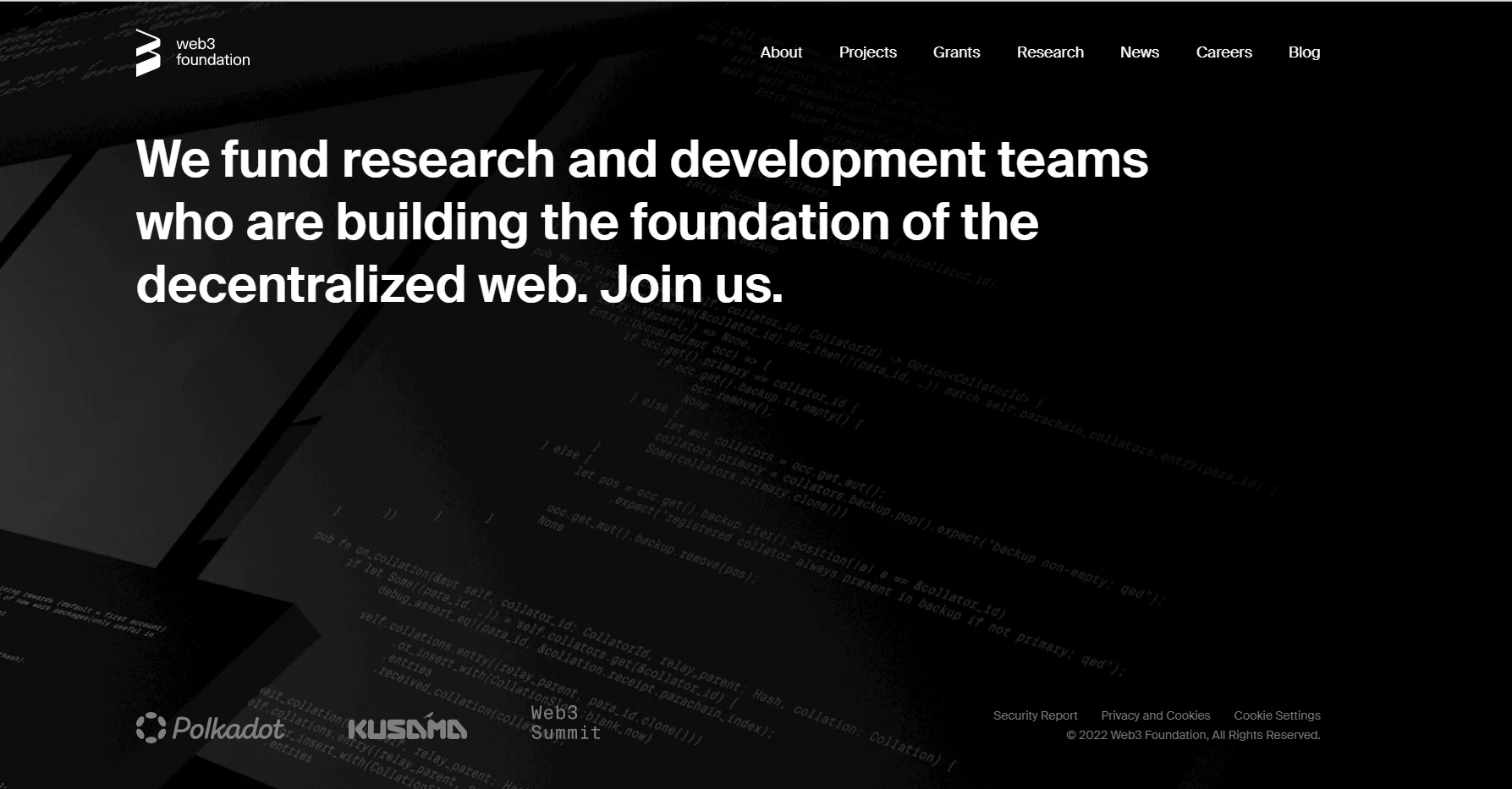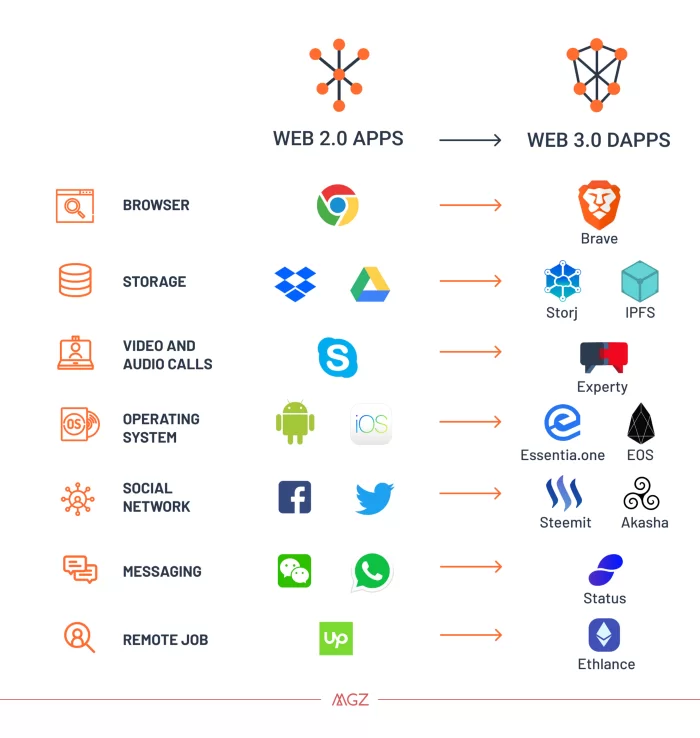The difference between Web 2.0 and Web 3.0 is that Web3 is more focused on the use of technologies like machine learning and AI to provide relevant content for each user instead of just the content other end users have provided. On one hand, Web 2.0 essentially allows users to contribute and sometimes collaborate on on-site content.
On the other hand, Web 3.0 will most likely turn these jobs over to the semantic web and AI technologies. If the trend of change is traced from Web 1.0, a static information provider where people read websites but rarely interacted with them, to Web 2.0, an interactive and social web-enabling collaboration between users, then it can be assumed that Web 3.0 will change both how websites are made and how people interact with them.
Important to realize, Web 3.0 has not yet been implemented. So, there is no solid definition that is exact on its main role as of the writing of this weblog. But, we’ll try to compile some known facts in this guide so that you can better understand more about it.
What Is Web 3.0?
Web3 (3.0) is the third generation of internet services for websites and applications that will focus on using a machine-based understanding of data to provide a data-driven and Semantic Web. The ultimate goal of Web 3.0 is to create more intelligent, connected, and open websites. While Web 2.0 refers to sites and apps that utilize user-generated content for end-users.
Web 2.0 is used in many websites today, chiefly focusing on user interactivity and collaboration. Web 2.0 also focused on providing more universal network connectivity and communication channels. It took over ten years to transition from the original web, Web 1.0, to Web 2.0, and it is expected to take just as long, if not longer, to fully implement and reshape the web with Web 3.0.
Ultimately, the technologies that some people believe are going to make up and ultimately define Web 3.0 are currently being developed. Smart home appliances using wireless networks and the Internet of Things (IoT) are two examples of how Web 3.0 is already impacting technology. Thus, Web3 is an extended Web, endowed with more meaning than Web1 or Web2.
Meaning, this is where any user can find answers to their questions faster. As of today, Cryptocurrencies and decentralization are changing how we interact with the web forever! And this is where Web 3.0 comes in handy. And now, let’s have a look at some of the key features of Web 1.0, 2.0 & 3.0 in detail below.
Web 1.0, 2.0 & 3.0 Key Features
So far, you already know that there’s plenty of buzz around Web3 and the sweeping changes it will bring to the industry. But, few people actually know why it spawned and what it will bring. To understand this, it’s necessary to travel back in time and examine its predecessors, Web 1.0 & Web 2.0. Just like the Middle Ages, Web1 wasn’t given its name until it bit the dust.
Eventually, the ‘World Wide Web’ as it was known, was just a set of static websites with a load of information and no interactive content. Connecting meant dialing up through rickety modems and blocking anyone in the house from using the phone. It was the web of AOL chat rooms and MSN messenger, of AltaVista and Ask Jeeves. It was maddeningly slow.
What about streaming videos and music? Forget it. Downloading a song would take at least a day. And then there was 2.0! The memory of bleepy modems and boring interfaces has largely floated away. Faster internet speeds paved the way for interactive content, the web wasn’t about observing anymore, it was about participating. Below are the key features that define Web 3.0.
Semantic Web
The succeeding evolution of the Web involves the Semantic Web. The semantic web improves web technologies in demand to create, share and connect content through search and analysis based on the capability to comprehend the meaning of words, rather than on keywords or numbers.
Artificial Intelligence
Combining this capability with natural language processing, in Web 3.0, computers can distinguish information like humans in order to provide faster and more relevant results. They become more intelligent to fulfill the requirements of users.
3D Graphics
The three-dimensional design is being used widely in websites and services in Web 3.0. Museum guides, computer games, e-commerce, geospatial contexts, etc. are all examples that use 3D graphics.
Internet Connectivity
With Web 3.0, information is more connected thanks to semantic metadata. As a result, the user experience evolves to another level of connectivity that leverages all the available information.
Applications Ubiquity
Content is accessible by multiple applications, every device is connected to the web, the services can be used everywhere.
With that in mind, the global sharing of information spawned the age of Social Media. Considerably, Youtube, Wikipedia, Flickr, and Facebook gave voices to the voiceless. As well as a means for like-minded communities to thrive. Remarkably, publishing this blog post will take me a hassle-free 30 seconds. An immeasurable improvement from when it took a concerted effort.
More so, between designers, developers and administrators just to make a simple edit to a website. We could call this the Read-Write-Publish’ era — where the spread of information is as simple as those three words. So, it begs the question, the web 2.0 is great, what went wrong? Well, in this article, you can read and learn more about that in detail.
Web 3.0 General Properties
Web 3.0 may be constructed with artificial intelligence (AI), semantic web, and ubiquitous properties in mind. The idea behind using AI comes from the goal of providing faster, more relevant data to end-users. A website using AI should be able to filter through and provide the data it thinks a specific user will find appropriate.
At the moment, there’s even a Web3 Foundation that is all about this. Whereby, it nurtures and stewards technologies and applications in the fields of decentralized web software protocols. To fully support their mission, their grants program funds software development and research in the field of decentralized software protocols.
That said, you can read and learn more About Web3 Foundation in detail. Whilst, if you are a focus-oriented webmaster, you can also visit their blog to learn more about new technologies they are working on. In nutshell, they fund research and development teams who are building the foundation of the decentralized web.
For your information, the Web3 Foundation supports Web 3.0 teams and open-source projects through funding, advocacy, research, and collaborations. So, interested in joining the team researching, supporting, and launching these projects?
Well, you can check out the Web3 Foundation Careers for more directions. Development projects funded through their grants are so broad. Including low-level infrastructure development such as alternative client implementations; ecosystem components such as wallets; and software designs. More so, in order to enable direct use cases such as identity and supply-chain modules.
How Web 3.0 Really Works
Technically, like any emerging technology is still being refined. For access to the decentralized web, people will only need a seed. This will be a single asset that enables the interaction with dApps and other services. Individuals will still use a web browser to access the internet, and visually it will be Web 2.0 user-friendly.
By the same token, on the surface, the learning curve from 2.0 to 3.0 will be gentle. But behind the scenes, the framework connecting users with digital services is markedly different. Forthwith, transactions are signed and verified manually, if I may add. More so, in order to prevent platforms from siphoning away personal information without due cause.
Web-users will opt-in rather than try — and often fail — to opt-out. You’ll learn more in detail from the video tutorial guide below.
In a layman’s language, the concept goes as follows: at present, the decentralized apps, wallets, platforms, and other digital assets that makeup Web 3.0 are scattered. Accessing these interfaces calls for separate seeds.
As well as logins, and identities — much like the existing Web 2.0. Essentia.one will link these disparate platforms together via a single seed. This will operate as an encrypted key that can be associated with its owner. And, as a result, Essentia will provide proof of identity. But, without giving up any more of that individual’s identity than is necessary.
Instead of:
- Google Drive or Dropbox, we have services like Storj, Siacoin, Filecoin, or IPFS technology to distribute and store files.
- Skype we have platforms like Experty.io while WhatsApp and WeChat, we’ll have Realtime Status.
- Operating systems such as iOS and Android, frameworks such as www.Essentia.one, and EOS provide a new web gateway.
- Akasha or Steemit will roleplay Facebook while Brave will serve as Chrome and Ethlance can take over from Upwork.
Just as Web 2.0 didn’t automatically extinguish Web 1.0 (still gathering dust around some parts of the internet), the move to 3.0 will take time and integration with existing online systems. The wheels have already been set in motion and the train has left the station. Web 3.0 is a revolution in motion, we are past the point of no return. Below are some example apps to consider.
As can be seen, above are just a few examples of Web3 to consider. After all, as it rears into action, new platforms will continue to emerge. Particularly, with a healthy level of competition — not throttled by monopolistic service providers. It’s likely the best dApps and decentralized services we’ll use three years from now are no more than a glimmer in their developer’s eye.
Why Web 3.0 Matters In This Technology Era
Of course, there are just so many reasons as to why Web3 matters, if I may begin. And the very first thing that comes to mind is generating wealth from the Internet. In other words, Web 3.0 could be seen as the answer to abuses of power in our current digital world. The decentralization of information and data is at the heart of this new vision of the internet.
Thus, as a result, Web3 would offer a more user-centric environment. Meaning, the digital giants would lose their dominance. Equally important, Web3 could be seen as the answer to abuses of power in our current digital world. The decentralization of information and data is at the heart of this new vision of the internet. Sometimes, the web is seen as a “Far West.”
Where (almost) everything was allowed under the cover of a pseudonym or a company. But, things could well change. Thanks to the blockchain, we could see the dawn of a web with more trust, and thus more valuable. And painting a picture of this new version of the web would inevitably involve quite a lot too.
Related Reading: Cryptocurrency | Types of Cryptos, Bitcoin Mining & Trading Tools
From Cryptocurrencies, NFTs, the Internet of Things (IoT), virtual reality (Metaverse), Cloud Computing (AI), etc. As such, Cryptocurrencies and NFTs would allow users to generate value easily.
On one side, Tokens of work or a currency could be exchanged in exchange for service in the system or a job. On the other side, Web 3.0 would offer a more user-centric environment and the digital giants would lose their dominance. Data monetization would no longer be able to be exploited in the same way, and for many, this would mean a major loss of revenue.
Still, the Metaverse could offer a significant new avenue of opportunity for large tech companies such as Meta, since the two worlds would complement each other to create a quality digital universe. While Web 2.0 democratized many power structures and created new opportunities, the economic engine is largely privatized and monopolized.
Facebook, Uber, and Airbnb have already created private networks for public infrastructure which they dominate. Meaning, Web3 is the antithesis of this, it’s about multiple profit centers sharing value across an open network. It’s easy to envision a not-too-distant future where crypto-based phones, VPNs, decentralized storage, and widespread Cryptocurrency wallets.
Related Reading: How To Mine Bitcoins For Free | Tools To Use & Trade With
The UN estimated internet users increased from 738 million to 3.2 billion from 2000 – 2015. That’s an unfathomable amount of data floating around, and as big digital corporations realized, personal information is an enormously valuable asset. So began the mass stockpiling of data in centralized servers, with Amazon, Facebook, and Twitter the biggest custodians.
People sacrificed security for the convenience of these services; whether they knew it or not, their identities, browsing habits, searches, and online shopping information were sold to the highest bidder. In other words, it all brings us to a future without the need for network and cellular providers that suspend or surveil our information.
That’s if we’re to avoid sleep-walking into a Black Mirror-style privacy dystopia, these are the tools we require. All in all, there are even more advantages that Web3 offers. And, as such, I’ll list them down below for you to fully understand.
#1: Uncentralized Control:
There’s also the removal of Middlemen from the blockchain equation, like Ethereum which provides a trust-less platform with unbreakable rules and full data encryption. Alphabet and Apple will no longer have control of user data. No government or entity will have the ability to kill sites and services, and no single individual can control the identities of others.
In addition, there are also no service solution interruptions. Namely, things such as account suspension and dramatic reduction of denial of service distribution. Simply, because there’s no single point of failure, thus minimal service disruptions. Storing data is also on basis of distribution nodes to ensure redundancy and multiple backups to prevent server failure or seizure.
#2: Ultimate Ownership:
End users will regain complete control of data and have the security of encryption. Information can then be shared on a case-by-case and permissioned basis. At present, big companies like Amazon and Facebook have factories of servers storing information on dietary preferences, income, interests, credit card details, and more.
It’s not merely to improve their services — marketers, and advertisers pay billions each year for the data. Likewise, consider things such as social bookmarking, if I may add. Social bookmarking as a search engine can provide better results than Google since the results are websites that have been voted on by users. However, humans can also manipulate these results.
Whereby, to separate the legitimate results from the falsified ones, the use of AI kicks in. And, therefore producing results similar to social bookmarking and social media, but without bad feedback.
#3: Reduced Breaches:
Because data will be decentralized and distributed, hackers would need to turn off the entire network, while state-sponsored tools such as Vault7, used by the three-letter agencies, would be rendered obsolete. At present, there’s a compliment to handing over user data by internet companies. Or rather, they succumb to having the entire database scrutinization.
Unfortunately, there’s no limitation to major data security threats or even intrusions. Such as terrorism; in 2017, Coinbase took the IRS to court over its demand to see the data of over 15,000 customers. The case, which Coinbase eventually lost, paved the way for government entities to pick over the finances of thousands of customers. And, with little due cause to justify the intrusion.
#4: Unlimited Operability:
Applications will be easy to customize and device-agnostic, capable of running on smartphones, TVs, automobiles, microwaves, and smart sensors. At present, applications are OS-specific and often run on a single operating system. For instance, many Android cryptocurrency wallets are unavailable on iOs, causing frustration for consumers who use multiple devices.
Uniquely, it adds expenses for developers tasked with issuing multiple iterations and updates of their software. Basically, the idea behind the semantic web is to categorize and store information in a way that helps teach a system what specific data means.
#5: Permissionless Blockchains:
Anyone can create an address and interact with the network. There’s no overstating of power to access permissionless chains. Barring of users is also on basis of their account, geography, income, gender, orientation, etc.
Or rather, a host of other sociological and demographic factors. There’s also an efficient cross-border transfer of wealth and other digital assets, anywhere in the world. An artificially intelligent web will also introduce virtual assistants. In particular, an element that’s already emerging today as an aspect built into a device or through third-party apps.
The Role Of Web 3.0 Sites In Backlinks
Web 3.0 sites are the key tools to assist you to increase your site ranking in SERPs like Google, Bing, etc. Whilst, offering do-follow backlinks for your website. Presently, the Google search engine is given the value of a web 3.0 website. On that note, such sites mainly support your ranking strategy by increasing the referral traffic and page view of your website or blog.
Overall, you can use web 3.0 sites for social media and video sharing sites to increase the high PR backlink and traffic. So, this is one of the most significant SEO off-page techniques which allow you to create high-quality backlinks. Web 3.0 sites also offer do-follow backlinks for your website or blog. Web 3.0 sites are the best source for referral traffic.
Learn More: Web 2.0 Websites Offer Powerful Supportive Backlinks
With millions of readers ready to access web 3.0 sites daily. That’s why Web 3.0 sites are very central for creating high-quality backlinks for your website. More so, in order to improve the website ranking in the search engine result. They also help in making your brand known to a wide market. But, for now, I suggest you use Internet 2.0 Sites on a routine basis for your website promotion.
Though you can also get advanced results from web 3.0 sites that contrast other content sharing doings. Such as web articles submission, blog commenting, article submission, press release submission, guest posting, microblogging, etc. And now, I want to describe the role of Web 3.0 to others too. For more info, you can see a full Web 3.0 Sites List to consider.
The Role of Web3 to Webmasters
In other words, a website should be able to understand words put in search queries the same way a human would, enabling it to generate and share better content. This system will also use AI; semantic web will teach a computer what the data means and then AI will take the information and use it.
Ubiquitous computing refers to embedded processing in everyday objects, which enables the intercommunication of devices in a user’s environment. Definitely, this’s yet another property that Web 3.0 will have. The concept is similar to the Internet of Things.
The technologies which will make up these properties include microformats, data mining, natural language search, and machine learning. Web 3.0 will also be more focused on peer-to-peer (P2P) technologies such as blockchain. Other technologies such as open APIs, data formats, and open-sourced software may also be used while developing Web 3.0 applications.
Generally, the Internet evolution towards Web 2.0 or Social Web came with the arrival of a new generation of technologies and online interactive applications. Notably, that allows easy publishing, editing, and distribution of content and creating personal networks and online communities. In fact, and although there is considerable confusion to note.
More so, between the literature about similarity and/or difference between Web 3.0 and Semantic Web. In this case, both concepts designate the same reality. In short, Web 3.0 marks the beginning to create a knowledge base and semantic and qualitative information.
The Role of Web3 to Marketers
From a marketing standpoint, this Web 3.0, allows you to build an advertising message. For dissemination through advanced digital technology. The semantic encoding of the said message may include information not present to the naked eye for the user. Hereby, in order to get an accumulation and customization of data more efficiently.
For example, in regards to any company that knows implement a strategy 3.0, which is based on four pillars. Thereby it pretends to store user preferences (tastes, customs, connectivity, interactivity, usability, etc.). And, at the same time, combining with existing content on social networks and mobile Internet, among others.
As well as, being able to attend to the information demands and facilitate access to digital content. Then again, as a result, provide an essential tool for advertising acceptance, adoption, flow, and functionality of the company. And, more so, in order to retain the user with the marks that appear in the network.
Indeed, small-scale companies have been implementing and using Web 3.0 technologies that use semantic data. Be that as it may, there’re four pillars that guide a Web 3.0 strategy. And, they are quite useful, especially, for beginner webmasters to consider.
The four pillars include:
- User-based content
- Multi distribution support
- Web media commitment (audio, video, image)
- Socializing mainly through social networks
That said, through social media, social networks, and other collaborative services, there’s semantic data mining. Like in Flickr, Delicious, Digg, extracting the semantic meaning and the profile of users in the respective network. Whilst, allowing the company to use interactive use of data and offering content with a presence in all networks and all devices (iPhone, iPad, etc.)
In short, Web3 technology (including the Semantic Web), according to its creators (W3C), is responsible for the definite meaning of words. And, as such, it helps Web content that may bear an additional significance beyond the textual meaning.
The Role of Web3 in e-Branding
In comparison to traditional branding (perception that a certain population has about a brand or product), e-branding is strategic management. That’s of the brand building in digital media. Thus, e-branding or online brand management, on Web 3.0, is one of the most ideal configuration tools. More so, for those business strategies focused on customer orientation.
For instance, those brands that are concerned about personalizing their message, in addition to interaction with the recipient. As well as considerate bidirectional maintenance with the customer in order to achieve loyalty. Indeed, companies need to know how the commercial message must be. And even, how to deal with a more elusive and restrictive user.
Bearing in mind, there are some users who base much of their decisions on the pulses generated through networks and virtual communities. The presence in them, of a merely decorative way or as passive reference point attempt is advance doom failure. Suffice to say, in a habitat where the fundamental becomes a semantic and qualitative connection to the user.
Perse, without the direct pressure of weight signature or commercial message. On that note, I’m quite against the consolidation of a new cycle in artificial intelligence. Often, combined with the ability of people to achieve the establishment of a direct, two-way, interactive. Whilst, constantly moving company-user communication in response to the user habits and demands.
Final Words
In reality, for some experts, Web3 is just a buzzword to get people talking. For others, it’s a revolution already underway. But, what does this term really mean, and will it really revolutionize the internet? Whether it’s a mere buzzword or a real revolution, Web3 seems to be a term that’s on everyone’s lips. With celebrations 33rd web anniversary, the internet is so essential.
More so, for many of our day-to-day activities. So much that it’s hard to believe that we could ever really disconnect. And even more so when tech giants are gathering more information and data every day. Specifically, in order to make our stay online and consume more. So, is an update really in order? There’s every indication that real change is coming.
Especially, with blockchain technology and decentralized solutions. Simply put, it means no holding by a single entity. But, by a set of unbreakable nodes to obtain 100% verifiable information. By this stage, Web 2.0 exponents were already dreaming up a successor. The next web, they envisaged, would take a nostalgic turn to the vision of web 1.0: more ‘human’ and more privacy.
RELATED TOPICS:
- Brave | A Free Web Browser That Pays Users For Browsing!
- CryptoTab Browser | Earn Free Bitcoins While Web Surfing!
- How QR Code Generator Works | Custom QR Codes Guide
- AdBlockers | Why Adblocking Is Web Marketers Nightmare
- What Is ISP Tracking? How To Protect Your Data Privacy
Not forgetting, the vision of a fairer and more transparent web dates back to around 2006. But, the tools and technologies weren’t available for it to materialize. However, Bitcoin was still three years off.
Whilst, bringing with it the notion of a distributed ledger, or blockchain, for peer-to-peer digital storage. Decentralization was the idea; blockchain was the means. But, changes can’t happen without your help!!!. Therefore, make sure that you spread around the voice or share this article. But, if you’ll need more help, you can always Consult Us and let us know how we can sort you out.
Not to mention, in order to support what we do, you can also Donate to even motivate our web content research team as well. Finally, make sure that you don’t miss all our latest blog updates by subscribing to our free newsletters form below.










You have made some good points there. I checked on the net for more information about
the issue and found most people will go along with your views
on this site.
You are welcome!
Comments are closed.